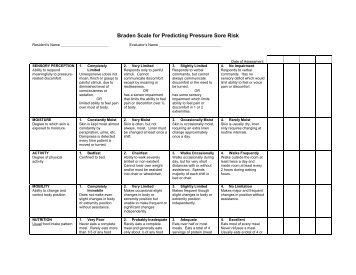Today, I want to talk about something that is very important in the world of nursing – the Braden Scale. For those who may not be familiar with it, the Braden Scale is a tool designed to help assess a patient’s risk of developing pressure ulcers. As a nurse, I have used this tool countless times in my career and I can attest to its effectiveness in preventing these painful and debilitating wounds.
Braden Scale for Predicting Pressure Sore Risk
 The Braden Scale was first introduced in 1987 by Barbara Braden and Nancy Bergstrom and has since become an essential part of nursing practice. It consists of six subscales – sensory perception, moisture, activity, mobility, nutrition, and friction/shear – which are used to determine a patient’s risk of developing pressure ulcers.
The Braden Scale was first introduced in 1987 by Barbara Braden and Nancy Bergstrom and has since become an essential part of nursing practice. It consists of six subscales – sensory perception, moisture, activity, mobility, nutrition, and friction/shear – which are used to determine a patient’s risk of developing pressure ulcers.
Skala Braden

Braden Q Scale
 One important thing to note about the Braden Scale is that it is not foolproof. A patient may still develop pressure ulcers even if they score low on the scale, and conversely, a patient may score high on the scale but not develop pressure ulcers. However, the Braden Scale is an important tool for identifying patients who are at increased risk and implementing preventative measures.
One important thing to note about the Braden Scale is that it is not foolproof. A patient may still develop pressure ulcers even if they score low on the scale, and conversely, a patient may score high on the scale but not develop pressure ulcers. However, the Braden Scale is an important tool for identifying patients who are at increased risk and implementing preventative measures.
PT Notes on Pinterest
 Some of these preventative measures include things like turning and repositioning the patient frequently, ensuring that the patient’s skin is clean and dry, and providing adequate nutrition and hydration. Medical devices such as pressure-relieving mattresses and cushions can also be used to help distribute pressure more evenly and reduce the risk of pressure ulcers.
Some of these preventative measures include things like turning and repositioning the patient frequently, ensuring that the patient’s skin is clean and dry, and providing adequate nutrition and hydration. Medical devices such as pressure-relieving mattresses and cushions can also be used to help distribute pressure more evenly and reduce the risk of pressure ulcers.
Braden Scale PDF
 It’s important for nurses to be familiar with the Braden Scale and to use it as an integral part of their assessment process in order to prevent pressure ulcers from developing in their patients. There are many resources available online, including printable versions of the scale, that nurses can use to increase their familiarity with the tool.
It’s important for nurses to be familiar with the Braden Scale and to use it as an integral part of their assessment process in order to prevent pressure ulcers from developing in their patients. There are many resources available online, including printable versions of the scale, that nurses can use to increase their familiarity with the tool.
Braden-Scale Chart – Igap Download Printable PDF
 Of course, the key to preventing pressure ulcers is to be proactive in assessing patients’ risk factors and implementing preventative measures before a pressure ulcer has the chance to form. By using tools like the Braden Scale, nurses can identify at-risk patients and take steps to prevent this painful and potentially life-threatening condition.
Of course, the key to preventing pressure ulcers is to be proactive in assessing patients’ risk factors and implementing preventative measures before a pressure ulcer has the chance to form. By using tools like the Braden Scale, nurses can identify at-risk patients and take steps to prevent this painful and potentially life-threatening condition.
Modified Braden Q Scale

What is the Braden Scale?
 I hope that this post has helped shed some light on the importance of the Braden Scale in nursing practice. By being familiar with this tool and using it regularly, nurses can play a vital role in preventing pressure ulcers and improving patient outcomes. Remember, prevention is key – so let’s work together to keep our patients healthy and comfortable.
I hope that this post has helped shed some light on the importance of the Braden Scale in nursing practice. By being familiar with this tool and using it regularly, nurses can play a vital role in preventing pressure ulcers and improving patient outcomes. Remember, prevention is key – so let’s work together to keep our patients healthy and comfortable.
Products
 Thank you for taking the time to read this post. If you have any questions or comments, please feel free to leave them below. And as always, stay tuned for more insights and tips from the world of nursing!
Thank you for taking the time to read this post. If you have any questions or comments, please feel free to leave them below. And as always, stay tuned for more insights and tips from the world of nursing!
Braden Pressure Ulcer Risk Assessment Printable PDF Download
 Disclaimer: The information contained in this post is for educational purposes only and should not be used as a substitute for professional medical advice, diagnosis, or treatment. Please consult your healthcare provider before making any healthcare decisions.
Disclaimer: The information contained in this post is for educational purposes only and should not be used as a substitute for professional medical advice, diagnosis, or treatment. Please consult your healthcare provider before making any healthcare decisions.